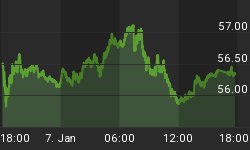Back in March, we pointed out some important similarities between the current financial environment and that of the 1970s.
Aside from gratuitous decades-old pop culture references, the main focus of the article was on real short-term interest rates, which we approximated by subtracting the year-over-year CPI inflation rate from the Fed funds rate. At the time, real rates by this measure had just turned negative, meaning that the Fed funds rate was actually lower than the rate of CPI inflation. We thought this an important development because the real Fed funds rate provides an indication of the tightness (or lack thereof) of monetary policy.
Checking back in on those real interest rates, we see that they have proceeded further into negative territory and now rest at -3.6%.

Real rates are now even lower than they ever got during the Fed's aggressive reflation campaign earlier this decade. They are, in fact, the lowest they've been since 1980. As measured by the real Fed funds rate, monetary policy is more accomodative than it has been for decades.
It's true that oil prices have pulled back, as we had forecast in our previous article, along with the prices of food and other raw materials. The resource price decline and the continuing economic slowdown could certainly cause CPI growth to drop somewhat from its most recent year-over-year growth rate of 5.6%.
However, assuming that the Fed funds rate remains unchanged, rates are so firmly negative that CPI inflation would have to drop to 2% just for the real Fed funds rate to get back to the zero level. We don't think this is going to happen.
We also feel fairly safe in assuming that the Fed funds rate will not be rising much any time soon. We speculated in our prior article that the impending drop in oil prices would allow the Fed to declare that inflation had been vanquished, thus providing themselves with cover to continue their loose monetary policy. Given that the continuing bloodbath in the housing market is now spilling over in an ever more obvious fashion to the rest of the economy and forcing the Fed to keep rates as low as they can for as long as they can, we believe that the Fed funds rate will not be raised in any significant manner.
In short, we think that real short-term rates will remain in negative territory for some time to come, and that monetary policy will continue to look more like it did in the inflationary 1970s than it did in the disinflationary 1980s and 1990s.
All other things being equal, negative real interest rates tend to exert the following effects:
- They discourage saving. People with cash in the bank are getting a rate of return that is too low to compensate them for purchasing power loss -- and it's even worse considering that savers have to pay tax on the interest income.
- They encourage borrowing for the same reasons that they discourage saving.
- They lead to increased speculation as investors seek higher returns to offset purchasing power loss.
- They lead to reduced confidence in the dollar as a store of value.
- They weaken the dollar against other currencies.
- They put upward pressure* on the prices of commodities and precious metals as people seek out alternate stores of value, among other reasons**.
* - Over longer time periods, that is -- short- to intermediate-term corrections are very much possible even in a long term bull market.
** - Other mechanisms by which real rates affect commodity prices have been explored by Harvard economist Jeffrey Frankel.
Does any of this sound familiar? A lot of it sounds like what happened in the 1970s, and even more of it sounds like what's been happening throughout the current decade. We expect the ongoing bout of negative real rates to be both protracted and supportive of these long-term trends.
- Read more investment articles at pcasd.com.
- Learn about how we can help investors benefit from the ideas presented in our articles.
- View our answers to frequently asked questions about what we do.
- Subscribe to our RSS feed.
















